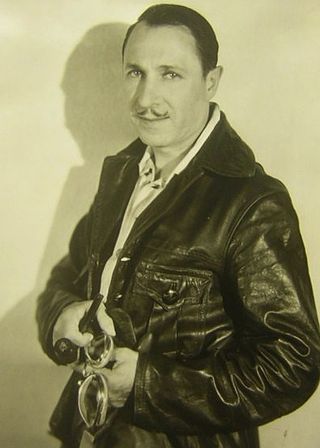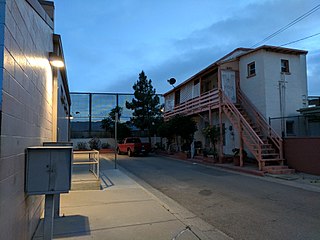
The Municipality and Borough of Skagway is a first-class borough in Alaska on the Alaska Panhandle. As of the 2020 census, the population was 1,240, up from 968 in 2010. The population doubles in the summer tourist season in order to deal with more than 1,000,000 visitors each year. Incorporated as a borough on June 25, 2007, it was previously a city in the Skagway-Yakutat-Angoon Census Area. The most populated community is the census-designated place of Skagway.

El Paso is a city in and the county seat of El Paso County, Texas, United States. The 2020 population of the city from the U.S. Census Bureau was 678,815, making it the 22nd-most populous city in the U.S., the most populous city in West Texas, and the sixth-most populous city in Texas. The city has the largest Hispanic population share of main cities in the U.S. at 81%. Its metropolitan statistical area covers all of El Paso and Hudspeth counties in Texas, and had a population of 868,859 in 2020.

EmeryValentine was an American politician and the sixth mayor of Juneau, Alaska, from 1908 to 1912 and from 1917 to 1919. He was also a miner, goldsmith, jeweller, assayer, gunsmith, watchmaker, architect, firefighter, and businessman.

Elephant Butte Dam or Elephant Butte Dike, originally Engle Dam, is a concrete gravity dam on the Rio Grande near Truth or Consequences, New Mexico. The dam impounds Elephant Butte Reservoir, which is used mainly for agriculture but also provides for recreation, hydroelectricity, and flood and sediment control. The construction of the dam has reduced the flow of the Rio Grande to a small stream for most of the year, with water being released only during the summer irrigation season or during times of exceptionally heavy snow melt.

KVIA-TV is a television station in El Paso, Texas, United States, affiliated with ABC and The CW. Owned by the News-Press & Gazette Company, the station maintains studios on Rio Bravo Street in northwest El Paso and a transmitter atop the Franklin Mountains within the El Paso city limits.
KCOS, branded on-air as PBS El Paso, is a PBS member television station in El Paso, Texas, United States, owned by Texas Tech University. The station's offices are located on Viscount Boulevard in east El Paso, and its transmitter is located atop the Franklin Mountains on the El Paso city limits. Its nominal main studio is located at Texas Tech-owned KTTZ-TV in Lubbock.
KFOX-TV is a television station in El Paso, Texas, United States, affiliated with the Fox network. It is owned by Sinclair Broadcast Group alongside dual CBS/MyNetworkTV affiliate KDBC-TV. The two stations share studios on South Alto Mesa Drive in northwest El Paso; KFOX-TV's transmitter is located atop the Franklin Mountains on the El Paso city limits.

El Paso County Coliseum is a multi-purpose indoor arena located in El Paso, Texas, United States. It opened on May 21, 1942 and was built originally to support a rodeo and livestock show, but later expanded to cater other types of events. A variety of events that have been held at the Coliseum have included hockey, high school graduations, basketball, boxing, circus, concerts, dog shows, flower shows, Ice capades, roller derby, wrestling and more. In addition to events, the Coliseum was also used to temporarily house prisoners of war, braceros and the Texas State Guard.

Northeast El Paso is part of the city of El Paso, Texas and is located north of Central El Paso, and east of the Franklin Mountains. Its southern boundary is variously given as Fred Wilson Boulevard or Cassidy Road and Van Buren Avenue, and it extends northward to the New Mexico state line; some portions of this region lie outside the city limits, including parts of Franklin Mountains State Park and areas of Fort Bliss: the Logan Heights area of Fort Bliss around Chapin High School and Castner Range National Monument, an old firing range northwest of Hondo Pass Drive and Gateway South Boulevard. Development of Northeast El Paso, which had begun before the Second World War around the Logan Heights area, started in earnest during the 1950s, when many homes were demolished in the process of the construction of Interstate 10. It is one of the more ethnically diverse areas of town due to a high concentration of military families. Northeast El Paso has historically not developed at a rate comparable to East El Paso and Northwest El Paso, but in recent years, it has seen an increase in development. It is expected that the population in Northeast El Paso will grow more rapidly as a result of the troop increase for Fort Bliss in the coming years. Northeast El Paso has gained recognition throughout the city for schools like Parkland, Irvin, Andress and Chapin because of their outstanding athletic programs.

Kern Place is a historic neighborhood on the West side of El Paso, Texas. The neighborhood lies just east of the University of Texas at El Paso, and north of downtown. Kern is part of District 1 in the City of El Paso and currently represented by Peter Svarzbein. The neighborhood was created by Peter E. Kern, and once had an unusual gate marking the entrance. Madeline Park in the center of the neighborhood is named after Kern's daughter. Businesses and a small entertainment district border the eclectic housing featured in the neighborhood.

Armand David Kali(s)z was an American stage and film actor of the silent film and early sound period of the 1930s. Prior to that, he was an actor in vaudeville and on the legitimate stage.

Edward Kern (1860–1912) was a politician and police chief from Los Angeles, California. He also served in the war against Geronimo.

The 1918 Arizona gubernatorial election took place on November 5, 1918, for the post of the Governor of Arizona. Thomas Campbell, who served a partial term in 1917 and had his election overturned by the Supreme Court of Arizona, returned to contest the Governors office. Incumbent Governor Hunt declined to run again after the stress of the close elections and the year-long court battle. Despite falling to its lowest percentage in years, the sole third party challenger held the difference between the two candidates. The Democratic challenger was state senator Fred T. Colter, a pro-Hunt Democrat.

Samuel C. Park was an American businessman and politician from Utah. A Republican, he served in the Utah State Senate from 1905 to 1909 and on the Salt Lake City School Board from 1909 to 1912. Park served as Mayor of Salt Lake City from 1912 to 1916.

Chihuahuita is a neighborhood in El Paso, Texas. It has also been known as the "First Ward." It is considered the oldest neighborhood in the city. It has also suffered through extreme poverty in its history. It is currently on the Most Endangered Historic Places list as compiled by the National Trust for Historic Preservation. It is located on the border of the Rio Grande at the Mexico–United States border. For most of the twentieth century, the name Chihuahuita was used to refer to all of southern El Paso, often including El Segundo Barrio. In 1991, Chihuahuita was designated as a historic district by the city of El Paso.

William Paul Brady was an American lawyer. From 1909 to around 1914, he served as the first district attorney for Texas' 70th judicial district, and from 1917 to 1919 he was the judge for the newly created El Paso County Court at Law. Brady prosecuted several high-profile murder cases as a district attorney, including of Agnes Orner, and in a death-penalty case that has since been termed a "legal lynching" of a Mexican boy charged with killing a white woman.
Ruth Ellen Kern was an American lawyer, community leader and feminist. Kern was an early pioneer in law for women in El Paso, Texas. She was also outspoken against myths regarding violence against women, sharing her own experiences with rape with the public. Kern was an active member of the American Civil Liberties Union (ACLU), and a law suit she filed for an inmate led to El Paso County to construct a new jail with better conditions for inmates.

The Roberts-Banner Building is a historic building in El Paso, Texas. Old adobe houses were demolished to make room for the construction of this five-story building in 1910. It was built with concrete, and designed by Trost & Trost. It has been listed on the National Register of Historic Places since September 24, 1980.

















